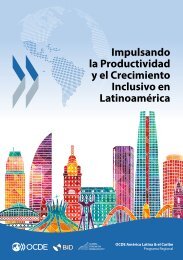WORKSHOP
gendergaps
gendergaps
Create successful ePaper yourself
Turn your PDF publications into a flip-book with our unique Google optimized e-Paper software.
Improving Opportunities for Women in the United States<br />
Improving Opportunities for Women in the United States<br />
OECD Washington Center, 17 June 2016<br />
Women’s economic opportunities have greatly improved in the<br />
United States over past decades, with benefit to overall society. Women<br />
increasingly outperform men at the various levels of education and are<br />
more likely than men to attend college and obtain a higher education<br />
degree. Women also tend to have better economic opportunities in the<br />
United States than in many other OECD countries, in particular in the<br />
job market. The share of women in managerial positions is particularly<br />
high by international comparison. The rise in female labour market<br />
participation provided an important boost to household incomes, helping<br />
to ease living conditions for families.<br />
Nonetheless, numerous challenges remain to further reduce gender<br />
inequalities. After years of rising presence in the labour force, the share<br />
of working-age women participating in the job market has declined<br />
since the mid-1990s and no longer appears significantly higher than the<br />
OECD area. In terms of wages, past progress made in the United States<br />
in narrowing the gender wage gap has lost some momentum recently<br />
and remains at about 17%, higher than on average in OECD countries. In<br />
addition, American women continue to make much more unpaid work<br />
than men, about 60% more.<br />
Further progress in reducing gender inequalities will require<br />
reforms in paid parental leave and childcare support, which have been<br />
found by empirical research to be important drivers of female labour<br />
force participation. Currently, the United States provides basic support<br />
for children, mothers, and fathers in the form of unpaid parental<br />
leave, child-related tax breaks, and limited public childcare. It is the<br />
only OECD country without a national paid maternity leave policy.<br />
Nationally-legislated unpaid job-protected leave is short (12 weeks), and<br />
only available to about 60% of workers. Paid leave payments with job<br />
protection are offered only by a few states and some employers as part<br />
of their employee benefit packages.<br />
Therefore, changes in job structure and remuneration, particularly<br />
if job flexibility comes at the cost of reduced hourly wages, are required<br />
to further closing gender wage gaps. Likewise, to advance women’s<br />
opportunities in the workforce, the United States needs to improve the<br />
flexibility of working arrangements, provide national access to paid<br />
family leave, and increase access to quality pre-school and childcare. The<br />
potential gains of implementing these measures are large, as they help<br />
get and keep more women in the workforce contributing to economic<br />
growth - closing the gender gap in labour force participation rates by<br />
2040 could increase GDP per capita by USD 4 300 -, reduce replacement<br />
and training costs for employers, offer cognitive and health benefits to<br />
children, and extend choice for parents in finding their preferred worklife<br />
strategy.<br />
In this context, the OECD Centre for Opportunity and Equality<br />
(COPE), the OECD Economics Department and the OECD Washington<br />
Center have invited policy makers, researchers, and members from the<br />
business community to discuss and provide insights on women and the<br />
workforce in the United States, the gender wage gap, working conditions<br />
and relevant family-friendly policies that would help to promote female<br />
labour force participation and contribute to higher economic growth by<br />
improving opportunities for women in the United States.<br />
3



